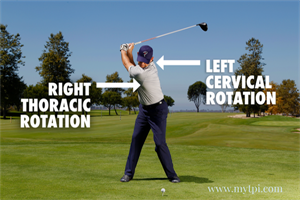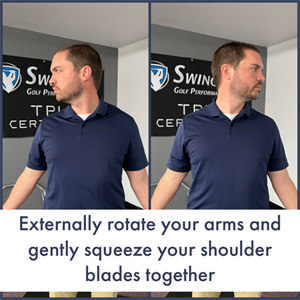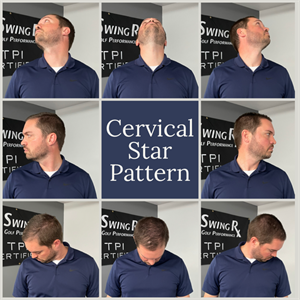 Many golfers have limited range of motion with their golf swing. Limitations during the back swing can be particularly problematic. There can be numerous factors for these limitations. Decreased external rotation with the lead hip, limited internal rotation of the trail hip or limited thoracic rotation are some of the common culprits. Many golfers have limited range of motion with their golf swing. Limitations during the back swing can be particularly problematic. There can be numerous factors for these limitations. Decreased external rotation with the lead hip, limited internal rotation of the trail hip or limited thoracic rotation are some of the common culprits. One area that is often overlooked with the golf swing is cervical rotation, or turning your head side to side. Many people don’t think that movement will have an impact on your swing but it is actually one of the screens people fail the most. During the backswing there should be 45 to 50 degrees of right thoracic rotation and at least 70 degrees of left cervical rotation for right handed golfers. If the golfer has limited cervical rotation we can see a number of compensations, but almost always we will see it combined with limited thoracic rotation. When we lose thoracic rotation we will try to make up for that by over using the shoulders or creating excessive rotation forces on the lumbar spine (ouch, don’t do that!). These compensations will not only lead to injuries, but it will also make it difficult for you to stay in posture during the swing which causes you to be very inconsistent. If the golfer fails the cervical rotation screen we will often go through more in depth assessments in the SFMA (Selective Functional Movement Assessment). During that assessment, we can determine whether the pattern is dysfunctional due to a joint restriction, soft tissue mobility restriction, or a stability motor control dysfunction. Cervical spine restrictions are usually due to degenerative joint/disc disease. The most common cause is some form of arthritic change in the vertebrae in the neck. This will limit the joint range of motion and make it difficult to achieve full rotation and flexion. Any tightness or fascial restrictions of muscles that support the neck, joint capsule, upper traps, scalenes, suboccipitals and SCM can also limit mobility. The following are corrective exercises to improve cervical rotation both with and without pattern assistance. Pattern assistance is when we use external cues to help the movement pattern. In this case, we are stabilizing the shoulders by performing a Brueggers posture. When we do that, it allows our cervical spine to better use the proper muscles to perform cervical rotation and not recruit accessory muscles.   | 
 Many golfers have limited range of motion with their golf swing. Limitations during the back swing can be particularly problematic. There can be numerous factors for these limitations. Decreased external rotation with the lead hip, limited internal rotation of the trail hip or limited thoracic rotation are some of the common culprits.
Many golfers have limited range of motion with their golf swing. Limitations during the back swing can be particularly problematic. There can be numerous factors for these limitations. Decreased external rotation with the lead hip, limited internal rotation of the trail hip or limited thoracic rotation are some of the common culprits. 

